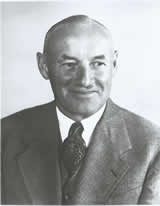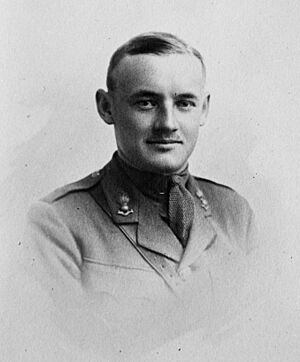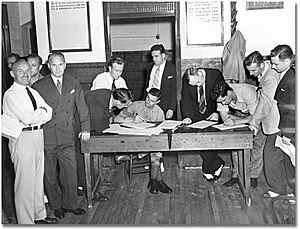Conn Smythe facts for kids
Quick facts for kids
Conn Smythe
|
|
|---|---|
 |
|
| Born |
Constantine Falkland Cary Smythe
February 1, 1895 |
| Died | November 18, 1980 (aged 85) Toronto, Ontario
|
| Resting place | Park Lawn Cemetery, Toronto |
| Nationality | Canadian |
| Education | Upper Canada College Jarvis Collegiate Institute University of Toronto |
| Occupation | Sports team owner Racehorse owner/breeder |
| Spouse(s) | Irene Sands |
| Children | Stafford Smythe (1921–1971) Miriam Smythe (Hoult) (1924–1983) Dr. Hugh Smythe (1927–2012) Patricia Smythe (1935–1945) |
| Parent(s) | Albert Smythe Mary Adelaide Constantine |
| Awards | Military Cross (World War I) Thoroughbred horse racing awards:
|
| Honours | NHL honours:
|
Constantine Falkland Cary Smythe (February 1, 1895 – November 18, 1980) was a Canadian businessman, soldier, and sports leader. He is most famous for owning the Toronto Maple Leafs hockey team from 1927 to 1961. He also built their famous arena, Maple Leaf Gardens. During his time as owner, the Maple Leafs won the Stanley Cup eight times.
Smythe also served in both World War I and World War II. He even created his own army unit in the Second World War. Outside of hockey, Smythe owned a successful sand and gravel business. His racehorses won many important races, including the Queen's Plate three times.
Contents
Early Life and Education
Conn Smythe was born in Toronto on February 1, 1895. His father, Albert, came from Ireland, and his mother, Mary, was from England. Conn was the second child; his older sister, Mary, passed away when he was young.
His family was not wealthy and moved often. Conn decided early on that he wanted to be called "Conn" instead of his birth name, Constantine. He later became a lifelong non-drinker.
Smythe first went to Upper Canada College for high school. He then moved to Jarvis Collegiate Institute. There, he became a strong athlete, playing hockey, rugby, and basketball. He helped his teams win city championships in basketball and hockey in 1912.
At 17, Smythe tried to become a farmer in northern Ontario. After a summer of hard work, his new home was destroyed by fire. He then returned to Toronto and studied engineering at the University of Toronto in 1912. He played hockey for the Varsity Blues team. He led them to the Ontario Hockey Association (OHA) junior championship in 1915.
Serving in World War I

In March 1915, just after winning the OHA championship, Smythe and his hockey teammates joined the army for World War I. He became a lieutenant and trained in Kingston, Ontario. He later joined the 40th (Sportsmen's) Battery.
In February 1917, Smythe showed great bravery. During a German attack, he bravely ran into the fight. He killed three German soldiers and helped wounded Canadian soldiers get to safety. For his actions, he was awarded the Military Cross.
Smythe later transferred to the Royal Flying Corps in July 1917. He worked as an airborne observer, helping to direct artillery fire. On October 14, 1917, he was shot down by the Germans and captured. He was held as a prisoner of war (POW) in Silesia for 14 months until the war ended.
Starting a Business and Joining the NHL
After the war, Smythe returned to Toronto. He used his army pay and money from selling his land to start a sand and gravel business. His company was called C. Smythe Limited, and its slogan was "C. Smythe for sand." His wife, Irene, helped by taking orders over the phone.
In the evenings, Smythe coached the University of Toronto hockey team. This led him to the NHL. In 1926, he was hired as the general manager and coach for the new New York Rangers team. However, he was fired before the team played its first game. Smythe believed it was because he refused to sign a player he thought wasn't a team player.
Smythe continued coaching the University of Toronto team, called the Varsity Grads. They won the Allan Cup and were chosen to represent Canada at the 1928 Winter Olympics.
Smythe Forms the Maple Leafs
While the Rangers were doing well, Smythe's hometown team, the Toronto St. Pats, were struggling. The St. Pats were about to be sold and moved to Philadelphia. Smythe quickly put together a group of investors to buy the team and keep it in Toronto. He invested $10,000 of his own money. The sale was completed on February 14, 1927. Soon after, the team was renamed the Toronto Maple Leafs.
Smythe became the team's governor and general manager. He also changed the team's colors from green and white to blue and white. He said blue represented the Canadian skies and white represented snow. These were also the colors of his sand and gravel trucks. For the next three years, he also coached the team.
Smythe was known for being a strong leader. He was very passionate about his team.
In 1929, Smythe decided the Maple Leafs needed a new arena, even during the Great Depression. The old arena could only hold 8,000 people, but the Leafs often had 9,000 fans. Smythe found a location on Carlton Street and secured funding. Construction on Maple Leaf Gardens began on June 1, 1931, and was finished in just five months, opening on November 12, 1931. To help pay for the building, construction workers were paid with shares in the new company, Maple Leaf Gardens Ltd., instead of some of their regular wages.
In the 1931-32 season, the Maple Leafs' first in their new arena, Smythe hired Dick Irvin as coach. Irvin led the team to their first Stanley Cup victory as the Maple Leafs.
Horse Racing Success
Smythe became interested in horse racing as a boy. He started owning horses in the late 1920s. One of his most famous early horses was a filly named Rare Jewel. She was not expected to win, but Smythe bet over $100 on her. She won the Coronation Futurity Stakes at 100-to-1 odds, earning Smythe over $10,000.
He used this money to buy star hockey player King Clancy for the Maple Leafs for $35,000. This purchase was only possible because of his winnings, as the other owners didn't want to pay such a high price.
Smythe sold his horses in 1940 when he went to fight in World War II. He returned to horse racing in 1954. He bought land in Caledon, Ontario, and started breeding horses. His most famous horse was Wonder Where, who won the Canadian Oaks in 1959 and was named Canadian Horse of the Year.
Smythe's horses won 145 major races during his lifetime. His stable won the Queen's Plate twice, with Caledon Beau in 1958 and Jammed Lovely in 1967. In 1977, he was inducted into the Canadian Horse Racing Hall of Fame.
Serving in World War II

In World War II, at age 45, Smythe joined the Canadian Army again. In 1941, he helped form the 30th Battery, an anti-aircraft unit made up of sportsmen. Smythe became the acting major and commander.
His unit was sent to England in 1942. In July 1944, they went to France. Within three weeks, Smythe was badly wounded when an ammunition depot was bombed. He suffered a spinal cord injury that affected him for the rest of his life. He was sent back to Canada in September on a hospital ship.
While recovering, Smythe spoke out about the need for more trained soldiers overseas. He believed the army was using soldiers who were not ready for battle. He gave a statement to The Globe and Mail newspaper, which was printed on the front page. Smythe's public comments helped draw attention to the issue. Eventually, more reserve troops were sent to Europe.
Leading the Maple Leafs
While Smythe was away at war, a committee ran Maple Leaf Gardens Ltd. When he returned, Smythe worked to become the president of the company. With the support of J. P. Bickell and a loan, Smythe bought controlling interest in Maple Leaf Gardens Ltd. He officially became president on November 19, 1947.
Smythe led the Maple Leafs during one of their greatest periods. The team won six Stanley Cups in 10 seasons between 1942 and 1951. Smythe was known for caring most about winning the Cup, because "winning sells tickets."
By the mid-1950s, the Leafs were not doing as well. In 1957, Smythe decided to let a new committee, led by his son Stafford, manage the team. This committee was known as the "Silver Seven." They hired Punch Imlach as general manager.
Smythe was a strict owner. Players who did not follow his rules were often traded or sent to the minor leagues. He was against players forming a union. However, the owners eventually agreed to some benefits for players, like pensions.
Later Years and Legacy
In 1961, Smythe sold most of his shares in Maple Leaf Gardens Ltd. to his son Stafford and two partners. He resigned as president but was given an annual allowance and an office at the Gardens. He stepped down as governor of the Leafs in 1962.
In 1964, Smythe disagreed with the plan to change the Canadian flag. He believed the old flag, the Canadian Red Ensign, should remain. He wrote many letters to politicians about it.
In 1966, Smythe sold his remaining shares and left the board of directors. He did this because a Muhammad Ali boxing match was scheduled at the Gardens. Smythe felt the Gardens was a place for sportsmen who had served their country. He believed accepting the fight put "cash ahead of class."
Conn and his son Stafford had disagreements for a while. But they made up before Stafford passed away in 1971.
Other Achievements and Honours
After World War II, Smythe became very involved in charity work. He helped create the Canadian Paraplegic Association in 1945. This organization helped veterans with spinal cord injuries. He also supported the Ontario Society for Crippled Children. In 1975, at age 80, Smythe helped build the Ontario Community Centre for the Deaf.
In 1960, Smythe started the Conn Smythe Charitable Foundation. This foundation gives money to charities in the Toronto area.
Smythe also oversaw the building of the Hockey Hall of Fame in Toronto in 1961. He was the Hall's chairman for several years.
The National Hockey League honored Smythe by creating the Conn Smythe Trophy in 1965. This trophy is given to the Most Valuable Player in the Stanley Cup playoffs. After his death, it was renamed the Conn Smythe Memorial Trophy. The NHL also named one of its divisions, the Smythe Division, after him from 1974 to 1993.
Smythe Park and Recreation Centre in Toronto is located where his old gravel pit used to be. A street in Toronto, Conn Smythe Drive, is also named in his honor.
His autobiography, Conn Smythe: If You Can't Beat 'Em in the Alley, was published after he died in 1981. The title came from his famous saying, "If you can't beat 'em in the alley, you can't beat 'em on the ice." He meant that his players should be tough and not let opponents bully them.
Conn Smythe was inducted into the Ontario Sports Hall of Fame in 1998.
Family Life
Conn Smythe married Irene Sands on March 17, 1920. They had four children: Stafford, Miriam, Hugh, and Patricia. Patricia sadly passed away at age ten in 1945. Hugh became a doctor. Stafford became involved in the family businesses, including the Maple Leafs.
Smythe's father passed away in 1947. Conn later joined the Theosophical Society, a spiritual group. He remained a member for the rest of his life.
Irene Smythe was diagnosed with cancer in 1963 and passed away on June 20, 1965. Smythe created the Irene Eleanor Smythe Pain Clinic at Toronto General Hospital in her memory.
Conn Smythe had a heart attack in 1978. His health declined, and he passed away at his home in 1980 at the age of 85. He is buried with Irene in Park Lawn Cemetery in Toronto.
Coaching Record
| Team | Year | Regular Season | Post Season | ||||||
|---|---|---|---|---|---|---|---|---|---|
| G | W | L | T | OTL | Pts | Finish | Result | ||
| TOR | 1927–28 | 44 | 18 | 18 | 8 | - | 44 | 4th in Canadian | Did not qualify |
| TOR | 1928–29 | 44 | 21 | 18 | 5 | - | 47 | 3rd in Canadian | Won in quarter-finals (7-2 vs. DET) Lost in semi-finals (0-2 vs. NYR) |
| TOR | 1929–30 | 44 | 17 | 21 | 6 | - | 40 | 4th in Canadian | Did not qualify |
| TOR | 1930–31 | 2 | 1 | 0 | 1 | - | 3 | 2nd in Canadian | (resigned) |
| TOR | 1931–32 | 1 | 1 | 0 | 0 | - | (interim) | ||
| Total | 135 | 58 | 57 | 20 | - | 136 | 2-2 (0.500) | ||
Source:
Images for kids
See Also
- List of family relations in the NHL


